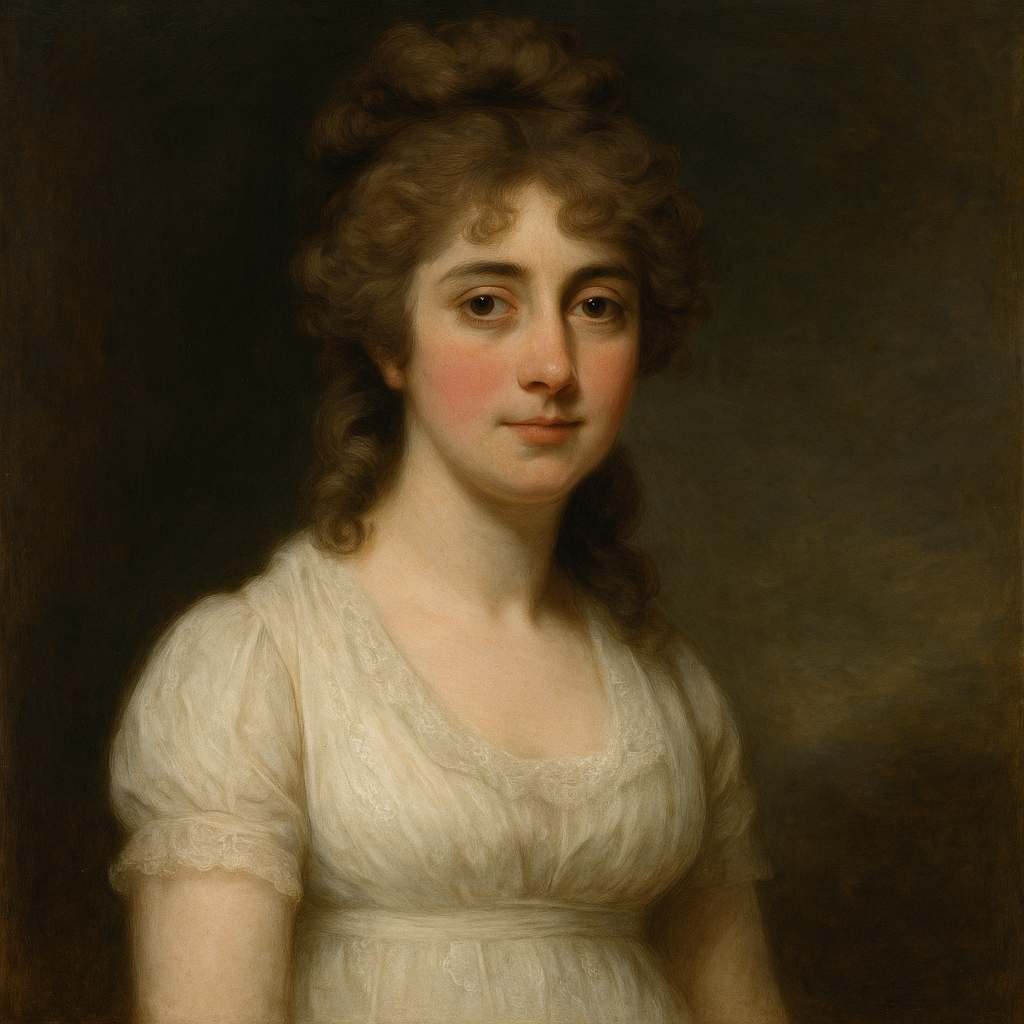The Voice of Him I Love
Amelia Alderson Opie
1769 to 1853

Want to track your favorites? Reopen or create a unique username. No personal details are required!
Hence far from me, ye senseless joys
That fade before ye reach the heart,
The crowded dome's distracted noise,
Where all is pomp and useless art!
Give me my home, to quiet dear,
Where hours untold and peaceful move;
So fate ordain I sometimes there
May hear the voice of him I love.
I hate e'en music's pleasing power
When giddy crowds my tones attend,
But love to sing at evening's hour
Too sooth the sorrows of a friend.
I love to breathe the plaintive lays
That Henry's heart and taste approve,
For, oh! how sweet in tones of praise
Appears the voice of him I love!
The praises I from others hear
Some joy may to my pride impart,
But Henry's wake the rapturous tear,
For his applauses touch my heart.
From busy crowds o'erjoyed I fly
With him in lonely shades to rove,
For e'en in gayest scenes I sigh
To hear the voice of him I love.
I woo the drama's magic powers,
Seek music's ever-crowded shrine,
In learning pass the studious hours,
Or try the muse's wreath to twine;
Yet still I feel a joy more dear,
Though I these pure delights approve,
When in retirement's scenes I hear
The soothing voice of him I love.
Amelia Alderson Opie's The Voice of Him I Love
Amelia Alderson Opie’s The Voice of Him I Love is a tender yet profound meditation on love, intimacy, and the rejection of superficial pleasures in favor of genuine emotional connection. Written in the early 19th century, the poem encapsulates the Romantic era’s valorization of personal feeling over social artifice while also reflecting the gendered expectations of female domesticity. Through its lyrical introspection, Opie crafts a work that is at once deeply personal and universally resonant, exploring themes of love’s quiet power, the contrast between public spectacle and private solace, and the transcendent nature of authentic affection.
Historical and Cultural Context: Opie’s World and Romantic Sensibilities
To fully appreciate The Voice of Him I Love, one must situate it within the literary and social milieu of early 19th-century Britain. Amelia Opie (1769–1853) was a prominent figure in literary circles, associated with both the radical intellectualism of her early years (she was friends with Mary Wollstonecraft and William Godwin) and the more conservative Quaker values she later embraced. This poem, likely written during her marriage to the painter John Opie, reflects a tension between public life and private devotion—a tension that many women writers of the period negotiated.
The Romantic movement, flourishing at the time, emphasized emotion, individualism, and a reverence for nature and solitude. Opie’s poem aligns with these ideals, rejecting the "crowded dome's distracted noise" in favor of the "quiet dear" of home. However, unlike the grand, often melancholy meditations of male Romantics like Wordsworth or Byron, Opie’s verse is intimate and domestic, centering on the personal rather than the sublime. This focus on the private sphere was both a reflection of and a subtle resistance to the era’s gendered expectations: while women were often confined to domestic roles, Opie elevates that domesticity into a site of profound emotional and aesthetic fulfillment.
Literary Devices: Crafting Intimacy Through Language
Opie employs a range of literary techniques to evoke the poem’s central themes of love and retreat from public life. The most striking is her use of contrast, setting the artificiality of social pleasures against the authenticity of private affection. The opening lines—
"Hence far from me, ye senseless joys / That fade before ye reach the heart"—
immediately establish a dichotomy between fleeting, external delights and enduring emotional truth. The "crowded dome" and "useless art" symbolize the hollowness of public admiration, while the home becomes a sanctuary where love’s voice is heard in its purest form.
Sensory imagery further deepens this contrast. Public spaces are associated with overwhelming, discordant sensations—"distracted noise," "giddy crowds"—whereas the private realm is characterized by soothing, harmonious sounds: the "plaintive lays" sung at evening, the "soothing voice" of the beloved. This auditory imagery reinforces the poem’s privileging of intimate communication over performative social interactions.
Another key device is anaphora, the repetition of phrases to create rhythmic and emotional emphasis. The refrain-like recurrence of "the voice of him I love" at the end of each stanza functions almost like a heartbeat, underscoring the constancy of the speaker’s devotion. Unlike the "senseless joys" that fade, this voice remains a fixed point of emotional reference.
Themes: Love, Authenticity, and the Rejection of Social Performance
At its core, The Voice of Him I Love is a celebration of emotional authenticity. The speaker explicitly rejects the performative aspects of social life—music sung for crowds, the "drama’s magic powers," even the pursuit of intellectual or artistic recognition ("the muse’s wreath"). These activities, though "pure delights," are ultimately secondary to the deeper fulfillment found in love’s private exchanges.
This theme resonates with broader Romantic critiques of Enlightenment rationalism and social artifice. However, Opie’s treatment is distinct in its gendered perspective. While male Romantics often sought transcendence in nature or solitary genius, Opie locates it in interpersonal connection, particularly within the domestic sphere. The poem thus challenges the notion that women’s writing was merely sentimental; instead, it presents domestic love as a legitimate and profound aesthetic experience.
A secondary but equally important theme is the power of the beloved’s voice. Unlike the empty praise of others, Henry’s words "touch the heart" and evoke "the rapturous tear." This suggests that true emotional impact comes not from public acclaim but from personal, reciprocal affection. The voice becomes a metaphor for emotional presence—an idea that anticipates later Victorian and modernist explorations of intimacy and communication.
Comparative Analysis: Opie in Dialogue with Contemporary Poets
Opie’s poem invites comparison with other Romantic-era works that explore similar themes. For instance, Wordsworth’s She Dwelt Among the Untrodden Ways also idealizes quiet, uncelebrated beauty, but where Wordsworth mourns a solitary figure lost to the world, Opie celebrates an ongoing, living relationship. Similarly, Felicia Hemans’ The Homes of England glorifies domesticity, but Opie’s treatment is more personal, less nationalistic.
A more striking parallel can be drawn with Elizabeth Barrett Browning’s Sonnets from the Portuguese, particularly How Do I Love Thee? Both poets frame love as a private, almost sacred experience, but Browning’s sonnets are more explicitly passionate, whereas Opie’s tone is tender and reflective. This difference may reflect Opie’s Quaker-influenced restraint, yet both poets share a conviction that love’s true depth is found away from the public eye.
Biographical Insights: Love and Loss in Opie’s Life
While biographical readings should not overshadow textual analysis, knowing that Opie wrote this poem during her marriage to John Opie adds poignant layers. John was a respected artist, and their relationship was reportedly affectionate, though his early death left Amelia widowed at 38. The poem’s emphasis on the beloved’s voice—"how sweet in tones of praise / Appears the voice of him I love!"—suggests not just admiration but a deep need for his presence. One might read the poem as both a celebration of marital happiness and an unconscious foreshadowing of its fragility.
Philosophical and Emotional Resonance: Why This Poem Endures
Beyond its historical and literary significance, The Voice of Him I Love remains compelling because of its emotional universality. In an age of digital distraction and performative social media, Opie’s rejection of "senseless joys" in favor of meaningful connection feels strikingly relevant. The poem speaks to anyone who has ever preferred a quiet evening with a loved one over the clamor of public approval.
Moreover, the poem’s quiet intensity challenges the modern tendency to equate love with grand gestures. Opie suggests that the most profound moments occur in stillness—listening to a voice, sharing a song, retreating into "lonely shades." This is love not as spectacle but as sustained, intimate presence.
Conclusion: A Quiet Masterpiece of Romantic Intimacy
Amelia Opie’s The Voice of Him I Love is a deceptively simple poem that rewards close reading. Through its skillful contrasts, evocative imagery, and emotional sincerity, it elevates domestic love to the level of high art. While it reflects its historical moment—the Romantic valorization of feeling, the gendered confines of women’s writing—its themes of authenticity and devotion transcend time.
In a literary canon often dominated by grand narratives of passion and loss, Opie’s poem reminds us that some of the most powerful emotions are found not in dramatic declarations but in the quiet, repeated certainty of a beloved’s voice. For that reason alone, it deserves recognition as a small but luminous gem of Romantic poetry.
This text was generated by AI and is for reference only. Learn more
Want to join the discussion? Reopen or create a unique username to comment. No personal details required!



Comments
No comments yet. Be the first to comment!